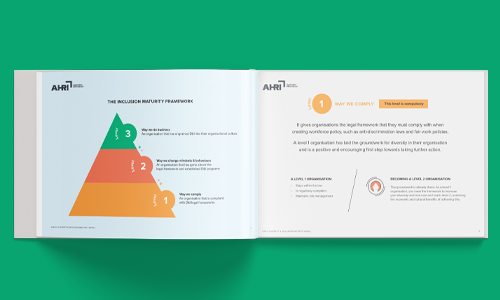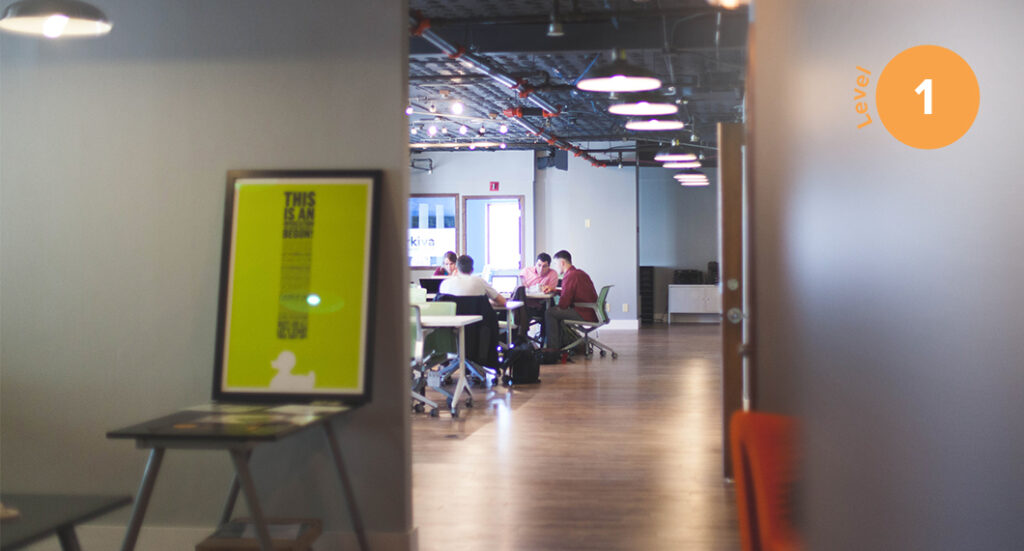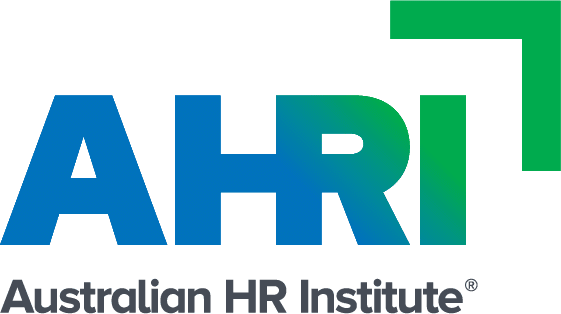Driving lasting change: A framework
In a globalised world, the business case for diversity management cannot be ignored. Being an organisation that focuses on diversity can have strong influence on the bottom line, reducing absenteeism, accelerating innovation and improving employee engagement.
Benchmarked against international best-practice organisations, the Diversity and Inclusion Maturity Model is a guide to help HR leaders, executive teams and stakeholders understand the business case for D&I, measure their current diversity management, and make a plan for the future.
In addition, AHRI’s Diversity, Equity & Inclusion Advisory Panel has developed a Futures Paper to support organisations, DEI specialists and HR professionals to build more productive and inclusive workplaces, and to further contribute to the practice of DEI in Australian organisations.

The Model – or Framework – is two-fold in purpose.
The first is to help diversity and inclusion practitioners engage their leadership and executive teams, explain the business case for D&I, and gain stakeholder buy-in.
The second is for HR and D&I practitioners to have a quick reference guide on how to improve diversity management in their organisation, give them resources to drive change and case studies for benchmarking.
Download the Framework for executive buy-in
Download the Maturity Model overview
Get started with D&I best practice with this handy webinar
Join HR and Diversity and Inclusion leaders Michelle Phipps FCPHR and Chris Lamb FCPHR as they discuss how the Maturity Model can help you progress D&I in your organisation – whatever your starting point.
The Three Levels of Maturity
All organisations fall into three categories – ‘levels’ – of diversity management. Each level is a representation of the effort and focus organisations place when it comes to diversity, inclusion and equity in their strategy.
Level One - Way we comply

Being at level one is compulsory for all Australian organisations. Level one organisations comply with Government-mandated policy such as fair work acts and anti-discrimination laws. A level one organisation has yet to implement D&I initiatives beyond the minimum required, but have good groundwork to launch them from. It will take effort and constant improvement to avoid sliding back down, but the benefits are worth it.
Anti Discrimination Laws
Australia’s Anti-Discrimination Laws
A Quick Guide to Australian Discrimination Laws
Leader & Employee Responsiblity
AHRC Workplace Discrimination and Harassment Policy Template
Workplace Gender Equality Agency Requirements
WGEA Reporting – Complying with the Act
ASX Corporate Governance
Fair Work Act 2009
Work Health & Safety Act
Work Health and Safety – regulations and codes of practice
Work Health and Safety Act 2011
Key Stakeholders
The Centre for Global Inclusion – Global D&I Benchmarking
Level Two - Way we change mindsets and behaviours

A level two organisation has moved beyond a tick-in-the-box approach, and gained leadership buy in to drive greater diversity management. They have established D&I programs, unconscious bias training and actively promote diverse events. They have yet to unlock the full business benefits that level three organisations enjoy, but they are well on their way and, given enough time, their culture will shift and evolve.
Diversity & Inclusion Strategy
AHRI – Strategies to Improve Diversity in the Workplace
AHRI 35 Tips to Improve D&I in the Workplace
DCA – Planning your D&I approach
Deloitte – Business case for Customer Diversity
Global D&I Benchmarketing
The Centre for Global Inclusion – Global D&I Benchmarking
DCA Inclusion @ Your Work Index
AHRI, DCA, SYD Uni Benchmarking Diversity & Inclusion Practices in Australia Report
Gender Insights & Research
Workplace Gender Equality Agency (govt compliance and employer of choice)
Reconciliation Action Plan
https://www.reconciliation.org.au/
https://www.reconciliation.org.au/reconciliation-action-plans/
Cultural & Faith Diversity
AHRI – Beyond the Pale – Cultural Diversity on ASX Boards
DCA – Creating inclusive multi-faith workplaces
DCA – Cracking the Glass Cultural Ceiling
Disability & Accessibility Insights and Research
LGBTIQ+ Insights & Research
http://www.prideinclusionprograms.com.au/about-pid/
http://www.prideinclusionprograms.com.au/resources/publications/publications/
Age Diversity
Flexibility

Level Three - Way we do business
A level three organisation has ingrained diversity and inclusion into the very DNA of their organisation. D&I is employee-led, supported by all and is a critical part of their wider operational strategy. Level three organisations become leaders and change-makers, ultimately giving back to the community in presentations at conferences and forums, and their programs are AHRI Award-winning.
Culture
Deloitte – Diversity and Inclusion Revolution
Deloitte – Six Signature Traits of Inclusive Leadership
Korn Ferry – The Inclusive Leader
Catalyst – Inclusive Leadership Report
DCA – Future Flex – Mainstreaming Flexibility
Global D&I Benchmarking
The Centre for Global Inclusion – Global D&I Benchmarking
DCA Inclusion @ Your Work Index
AHRI, DCA, SYD Uni Benchmarking Diversity & Inclusion Practices in Australia Report
Future of Work
CEW – Engaging the Future of STEM
Start a meaningful D&I conversation today
Related Articles
It’s time to move beyond the ‘business case’ narrative for gender equality at work
Five ways to move the needle on diversity and inclusion in your organisation
Stepping up your LGBTIQ+ inclusion initiatives
Gender pronouns: how to avoid misgendering employees
Creating a safe environment for employees to come out at work
How to support employees going through gender affirmation
Bucking the binary: how to support trans and gender-diverse staff
Critical steps to advance gender equality on International Women’s Day, and every day
